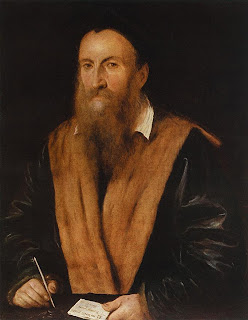 |
Portrait of Girolamo Romano,
painter of the disputed artwork known as
Cristo Portacroce Trascinato Da Un Mangoldo. |
In support of the warrant seizing Christ Carrying the Cross Dragged by a Rogue (Cristo Portacroce Trascinato Da Un Manigoldo) from The Mary Brogan Museum of Art and Science and in support of the civil complaint seeking forfeiture, the US Attorney for the Northern District of Florida supplies important details about the artwork’s asserted history. Homeland Security Investigations (HSI) agent Phillip Reynolds describes facts in an affidavit submitted to the federal district court that permits the construction of the following timeline and details:
June 1914 – Art collector Federico Gentili di Giuseppe, Italian and of Jewish descent and living in Paris, purchased the Cristo Portacroce from the Crespi family collection. The 16th century painting by artist Girolamo Romano, was lawfully exported from Italy.
April 20, 1940 – Just before the Nazi invasion of France, Federico Gentili di Giuseppe died and left his estate to his son and daughter. They fled Paris without their possessions.
March 17, 1941 – The French Vichy government ordered the liquidation of the entire Gentili di Giuseppe estate.
April 23, 1941 – The Cristo Portacroce, and dozens of other paintings once in the Gentili di Giuseppe family’s possession, were auctioned. “Lemar” of Paris reportedly bought the Cristo Portacroce.
1994 – A Girolamo Romani catalog raisonné published by Alessandro Nova listed the Cristo Portacroce as having been owned by Federico Gentili di Giuseppe.
1997 – Descendants of Federico Gentili di Giuseppe sued the Louvre for the return of five paintings sold during the same auction as the Cristo Portacroce.
1998 – The Brera Art Gallery (Pinacoteca di Brera) took possession of the painting, although no details are provided regarding this transfer.
June 2, 1999 – a French court ordered custody of the five paintings at the Louvre to Federico Gentili di Giuseppe’s descendants, acknowledging that the 1941 auction was a “nullity” in that several painting were purchased by Nazis, including Luftwaffe chief Hermann Göring. The court also ordered the Louvre to pay 40,000 francs (approximately $8300).
After June 2, 1999 – The Art Institute of Chicago, the Boston Museum of Fine Arts, and the Art Museum of Princeton University all returned works of art to the Gentili di Giuseppe family heirs. Institutions in Berlin, Cologne, and Lyons did the same.
January 10, 2000 and March 14, 2000 – Lawyer Jean Pierre Sulzer twice contacted the the Brera Art Gallery by mail on behalf of Gentili di Giuseppe’s descendants, receiving no reply.
2001 – The Brera Art Gallery referred the restitution claims of the Gentili di Giuseppe heirs to the Italian Ministry of Culture, and attorneys for the family wrote a letter to the ministry on October 3, 2001 asking for the painting.
June 6, 2002 – The Commission for Art Recovery of the World Jewish Congress, a New York based group that seeks to restitute cultural property taken from Holocaust victims, wrote a letter to Italian President Silvio Berlusconi after the Ministry of Culture reportedly rejected the claims of the Gentili di Giuseppe family. The letter urged the president to reconsider Italy’s position. (The contents of the letter suggest that the Brera made an earlier reply stating that it acquired the painting–and a second painting–in good faith. The Brera’s letter is not contained in court documents).
March 14, 2003 – The Italian Ministry of Culture responded to the Commission for Art Recovery’s intervention by saying that it carefully reviewed the matter in light of the Washington Principles and could not find that it could accommodate the request for repatriation. (See the Washington Principles
here).
2006 – The Commission on Looted Art in Europe reportedly contacted the Italian government in an effort to have the Christo Portacroce returned.
March 18, 2011 – The Brogan placed the painting on display at its museum in Tallahassee, Florida.
November 4, 2011 – The loan contract between the Brera and the Brogan was due to terminate on November 6, and the painting was to be delivered to Italy. Immigration and Customs Enforcement (ICE seized the painting on November 4, 2011 to prevent its return to Milan, and the US Attorney filed its in rem action against the artwork seeking its forfeiture.
The prosecution will seek to prove these alleged facts as it attempts to convince the federal district court that it has the evidence to forfeit the
Cristo Portacroce. Time will tell if any party steps forward to contest the claim.
See Part I for a discussion of the US government’s asserted legal claims in this case.
©2010-2022 Cultural Heritage Lawyer Rick St. Hilaire. Content discussing cultural heritage law, art law, looted antiquities, stolen artifacts, and museum risk management that is general information only, not legal advice.


